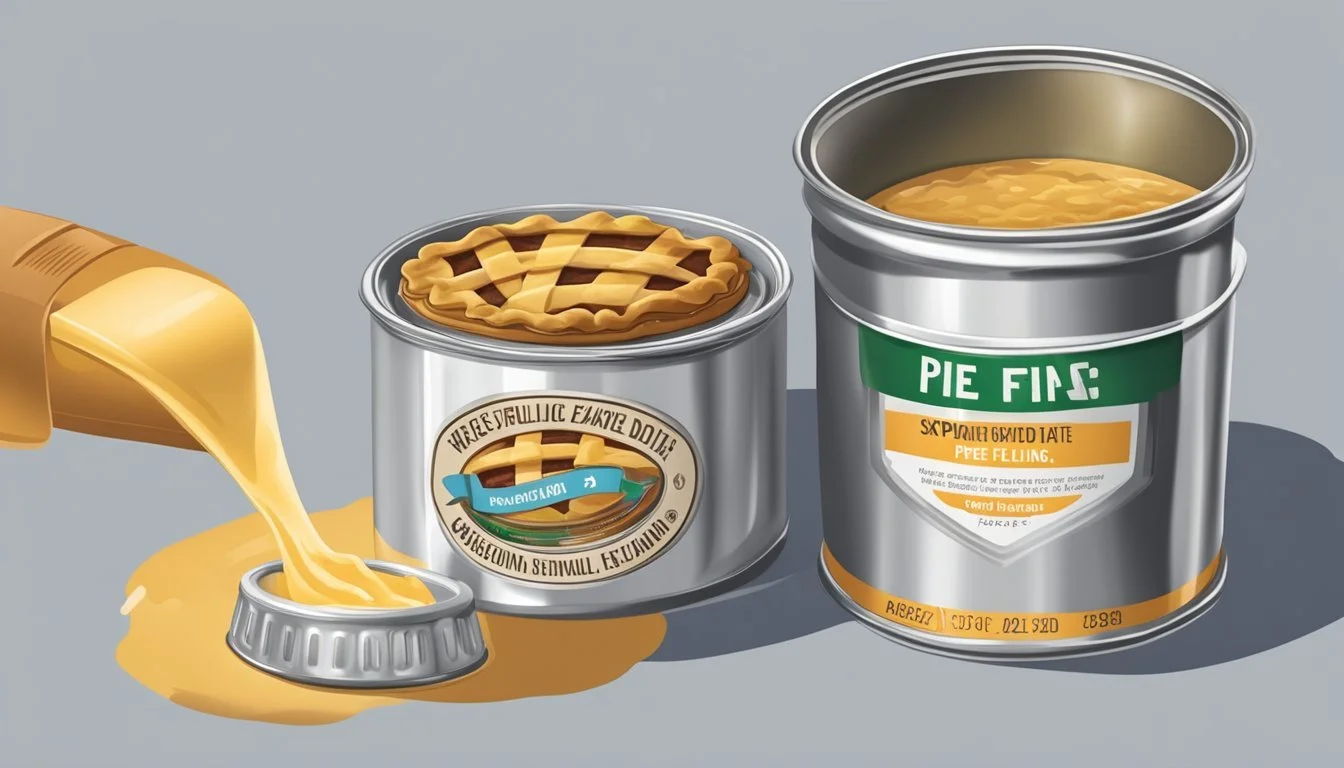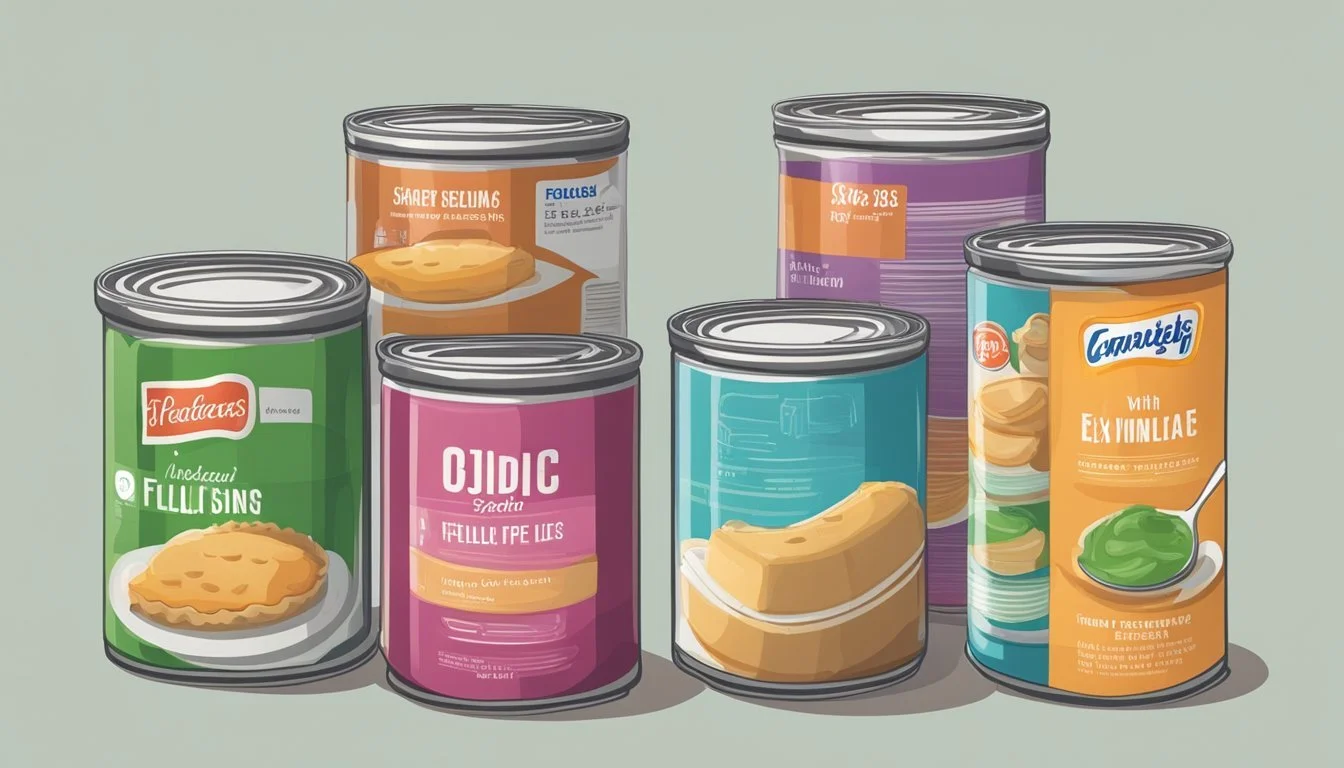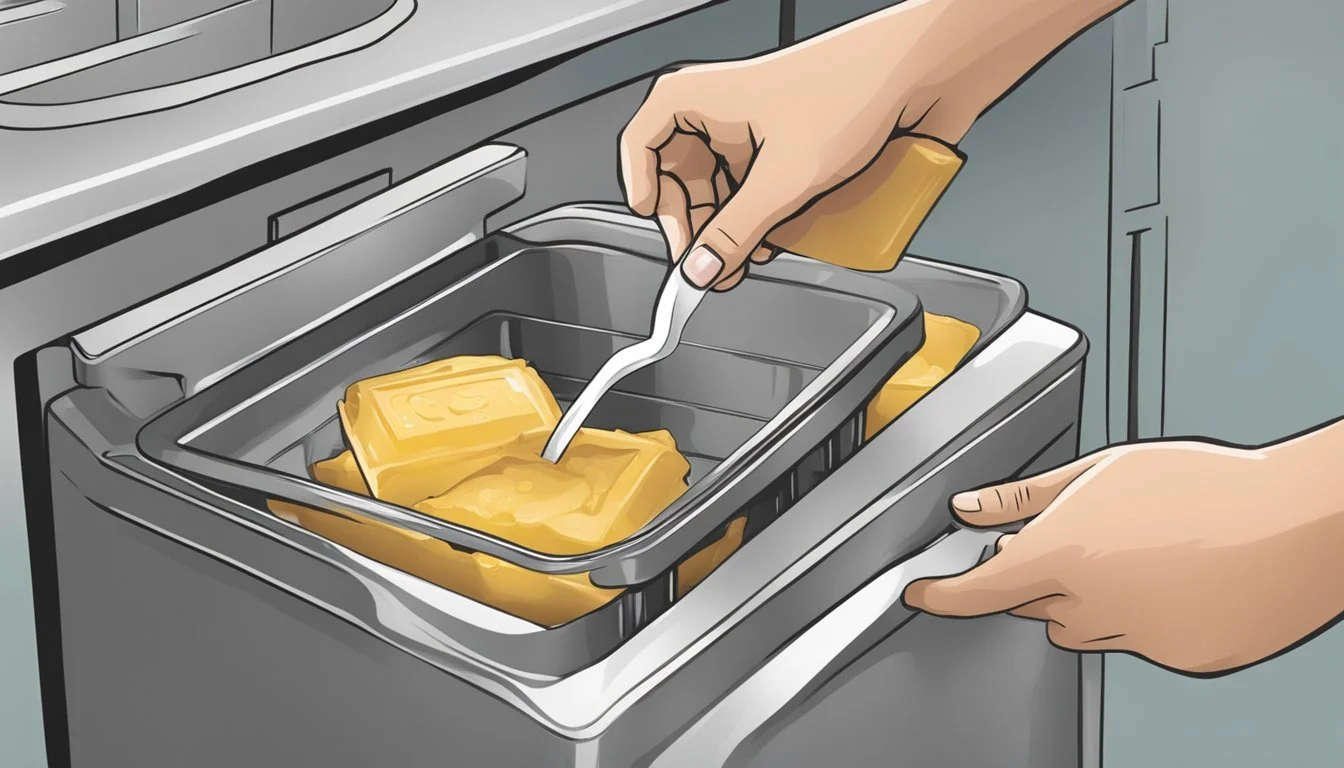Does Canned Pie Filling Expire?
Storage Tips and Shelf Life Explanation
Canned pie filling is a convenient and popular option for baking enthusiasts, but many wonder about its longevity and whether it truly expires. The expiration date on canned pie filling provides an important guideline, but unopened cans of pie filling typically remain safe to use for up to 1-2 years if properly stored. The fill stays in its best quality during this time when kept in a cool, dark place.
Storage conditions play a crucial role in determining the shelf life of canned pie filling. If the can or jar is undamaged and has been stored under favorable conditions, the pie filling can be safe to consume even past the indicated expiration date. However, once the can is opened, it should be refrigerated and consumed within 7-10 days.
Consumers should always check for signs of spoilage, such as unusual smells or changes in texture, before using the filling. Properly stored and undamaged canned pie filling offers a reliable and tasty option for sweet treats well beyond the printed date when these guidelines are followed.
Understanding Expiration and Best-By Dates
When addressing whether canned pie filling expires, it is crucial to understand the distinctions between various dates on packaging. This section will cover important aspects, such as the meanings of different dates and how to interpret them effectively.
Definitions and Differences
Expiration Date: This is the final date on which the manufacturer guarantees the product's safety and quality. After this date, the manufacturer can no longer ensure that the product is safe to consume.
Best-By Date: This indicates when the product is expected to be at its peak quality. It does not necessarily mean the product is unsafe to eat after this date, but the quality may decline.
Sell-By Date: This is used by retailers to indicate the last day the product should be sold, typically allowing for a reasonable period for consumer use. It doesn't directly relate to the product's safety but helps manage its shelf life.
Safety Date: More geared towards consumer safety, this date ensures that the product will remain safe for consumption if stored properly. Unlike best-by or sell-by dates, this focuses on health implications.
Interpreting Manufacturer's Dates
Manufacturers provide these dates to inform consumers about the length of time the product will retain its best quality. Reading these dates helps consumers make informed decisions on storage and usage.
Best-by Date: Emphasizes the quality of the product rather than safety. A can of pie filling may still be edible a year after this date, but its flavor or texture might be compromised.
Expiration Date: Demands more attention, as using the product post this date can pose health risks. Checking this date ensures safety.
Peak Quality: Manufacturers often estimate this based on storage conditions and ingredients. This reflects when the product is most flavorful and nutritious.
Understanding these dates can help consumers minimize waste and maximize product longevity. Proper storage and adherence to these dates are key.
Canned Food Lifespan
The lifespan of canned food varies significantly based on type, storage conditions, and packaging integrity. Low-acid foods like meats differ in shelf life compared to high-acid foods like fruits. Several factors can affect the longevity and quality of canned goods.
General Shelf Life
Canned foods, in general, have a long shelf life when stored properly. The USDA states that most canned goods last several years if their cans remain in good condition. Low-acid canned foods, such as meats and vegetables, can last anywhere from 2 to 5 years.
High-acid foods, such as fruits and tomatoes, typically last 1 to 1.5 years. The "expiration date" usually refers to the period during which the product maintains best quality, not necessarily when it becomes unsafe to eat.
Factors Affecting Longevity
Several factors influence how long canned foods remain safe and of good quality:
Storage Conditions: Storing cans in a cool, dry place away from extreme temperatures can significantly extend their shelf life.
Packaging Integrity: Cans that are dented, rusted, or swollen can compromise the food's safety and should be discarded.
Type of Food: Low-acid foods tend to last longer than high-acid foods. For example, canned meats and vegetables have a longer shelf life compared to canned fruits.
Nutritional Value: Over time, the nutritional value of canned foods may degrade. Vitamins can diminish, although calories, proteins, and minerals remain relatively stable.
By considering these factors, one can ensure that canned foods are stored and used effectively, maintaining both safety and nutritional value.
The Risks of Spoilage
Unopened canned pie filling can last a long time, but spoilage is always a potential risk. Understanding the signs of spoilage, and the health consequences of consuming spoiled filling, are crucial for safety.
Signs of Spoiled Canned Fillings
Spoiled canned pie fillings can exhibit several warning signs. A foul odor is often the first clue, signaling that bacteria or mold have developed.
Bulging cans indicate gas production by microorganisms inside, which is another serious red flag. Leaks or rust on the can may compromise its integrity and lead to contamination.
Discoloration or a change in texture are visible indicators that the filling is no longer safe to eat. If the contents appear to have mold or any other unusual growth, they should be discarded immediately.
Consequences of Consuming Spoiled Fillings
Eating spoiled pie filling can lead to severe health issues. Foodborne illnesses such as stomach cramps, diarrhea, and vomiting can occur after consumption.
The risk of botulism, a life-threatening illness caused by toxins produced by the bacteria Clostridium botulinum, is particularly high with improperly processed or stored canned foods.
Consuming contaminated food can also lead to long-term health problems, including severe dehydration and organ failure in extreme cases. It is essential to take any signs of spoilage seriously to avoid such health risks.
Storage Conditions for Optimal Preservation
Proper storage is crucial to ensure the longevity and quality of canned pie filling. It involves keeping unopened cans in specific conditions and handling opened cans with care to maintain freshness.
Unopened Canned Filling Storage
Unopened cans of pie filling should be stored in a cool, dark, and dry place. Ideal temperatures range from 50°F to 70°F (10°C to 21°C). Avoid areas exposed to excessive heat or direct sunlight, such as near ovens or windows, as these can accelerate spoilage.
It's best to store the cans in a pantry or cupboard away from moisture to prevent rust and contamination. Ensure the storage area is free from temperature fluctuations. This method helps preserve the filling's taste, texture, and nutritional value. Shelving units or storage bins can keep the cans organized and accessible.
After-Opening Storage Recommendations
Once the can is opened, transfer any unused pie filling to an airtight container. This prevents contamination and retains moisture. The filled container should be placed in the refrigerator, where it can stay fresh for up to five days.
For longer storage, consider freezing the pie filling. Place the filling in a freezer-safe container, leaving some space at the top for expansion. Properly stored, the filling can last for several months in the freezer. Label the container with the date of storage to track the duration.
Adhering to these storage conditions ensures that both unopened and opened canned pie fillings maintain their quality and safety for consumption.
Signs of Potential Problems
When assessing canned pie filling, several signs can indicate potential issues with the quality or safety of the product. Key indicators include visual clues, signs of physical damage, and changes in odor and texture.
Visual Inspections
Careful visual inspection is crucial. Look for bulging or swelling in the can, as these can indicate bacterial growth. Mold is another red flag; it may appear as green, black, or white spots on the surface. Pay attention to the color of the filling. A darker or discolored appearance might suggest spoilage or prolonged storage beyond its best quality.
Regular visual checks can help detect signs before opening the can. Address any unusual findings immediately to ensure safety.
Physical Damage and Corrosion
Inspect the can for any physical damage such as severely dented areas, especially around the seams. Such dents can compromise the can's integrity, potentially leading to contamination. Rust or corrosion on the can's exterior should not be ignored as they may lead to leaking or weakened seals.
If you detect rust or rusting on the can, consider it a sign that the contents may no longer be safe. Dispose of cans showing such physical damage to avoid health risks.
Odor and Texture Changes
Upon opening the can, take note of any off odor. The filling should typically have a sweet, pleasant smell. An unpleasant, sour, or musty odor can indicate bacterial or fungal growth. Examine the texture of the filling as well. It should be consistent and smooth. Any unusual changes in texture, such as lumpiness or excessive liquid separation, can signal spoilage.
Detecting these signs early ensures that you avoid using potentially dangerous or poor-quality filling in your recipes.
Handling and Using Canned Pie Fillings
Canned pie fillings can be a convenient and versatile ingredient for a variety of dishes. This section covers the essentials for opening, using, and extending the life of your favorite pie fillings like cherry, apple, and pumpkin.
Opening Methods
Opening a can of pie filling requires basic tools and careful handling. Commercially canned pie fillings come with a seal that must be broken to access the contents.
Can Opener: Use a reliable can opener to remove the lid safely.
Safety: Ensure the edges of the opened can are smooth to avoid cuts.
Storage: For partial cans, transfer the remaining pie filling to an airtight container to maintain freshness.
Culinary Uses
Canned pie fillings are not just for pies. They can be incorporated into a variety of recipes:
Pies: Classic cherry pie, apple pie, or pumpkin pie.
Desserts: Use as a topping for chiffon cakes or mix into trifles.
Savory Dishes: Surprisingly, some savory recipes benefit from a bit of sweetness. Try a dollop of apple pie filling with canned ham.
Enhancements: Add spices or fresh ingredients to enhance flavor and texture.
Precautions While Cooking
When using canned pie fillings in cooking, certain precautions should be taken to ensure the best results and safety.
Check for Freshness: Examine for signs of spoilage such as off-smell, taste, cloudiness, or mold.
Cooking Time: Most canned fillings are pre-cooked; adjust your recipe's cooking time to avoid overcooking.
Mixing: Stir fillings thoroughly to even out the texture and flavor before adding to recipes.
Extending Pie Fillings Beyond Opening
Once a can of pie filling is opened, extending its shelf life involves proper storage and handling.
Storage: Transfer unused filling to a clean, airtight container and refrigerate. Consume within a week for best quality.
Freezing: Pie fillings can be frozen for longer storage. Place the filling in a freezer-safe container, leaving some space at the top for expansion.
Creative Uses: Leftover fillings can be repurposed in innovative ways—stir into yogurt, blend into smoothies, or create parfaits.
Using these methods ensures the longevity and versatility of canned pie fillings, allowing them to be a handy ingredient in any kitchen.
Maximizing the Lifespan of Pie Fillings
Proper techniques for sealing, refrigeration, freezing, and appropriate repackaging can significantly extend the shelf life of pie fillings.
Proper Sealing Techniques
Proper sealing of canned pie fillings is crucial for maximizing their storage life. Always ensure that the package is undamaged and tightly sealed. A sealed container helps maintain the quality and safety of the contents.
When using homemade fillings, it's important to use airtight containers. Metal lids with rubber seals and vacuum-sealed jars work best for retaining freshness. For store-bought pie fillings, check for any dents or bulging in the can, as these can indicate compromised quality.
Refrigeration vs. Freezing
Whether to refrigerate or freeze pie fillings depends on how quickly they will be used. For short-term storage, refrigerating in an airtight container is effective, keeping the filling fresh for up to two weeks. Always ensure the container is tightly sealed to prevent absorption of odors from the fridge.
For long-term storage, freezing is the best option. Use freezer bags or sealed containers to store the filling. Before freezing, it's advisable to portion out the filling to avoid thawing and refreezing, which can degrade quality. Label bags with the date of freezing to keep track of storage times.
Repackaging for Storage
Repackaging can be a game-changer when it comes to extending the shelf life of pie fillings. For opened cans, transfer the contents to an airtight container or heavy-duty freezer bag. Ensure that the container is tightly sealed to prevent air exposure, which can reduce the filling's quality.
If planning to store for a very long period, consider a vacuum sealer to remove air before sealing the container. This process is particularly useful for homemade pie fillings or when buying in bulk. Always store these repackaged containers in a cool, dry pantry or freezer to maintain optimal quality.
Safe Disposal of Expired Fillings
Expired canned pie fillings pose health risks if consumed. Knowing the signs of spoilage and the proper methods for disposal ensures safety and minimizes foodborne illnesses.
When to Discard
Canned pie fillings should be discarded if they exhibit signs of spoilage.
Indicators include an off smell, mold, or changes in texture, such as becoming cloudy or thick. Check the "best by" date on the can; although some fillings may be safe past this date if stored correctly, it is safer to discard if in doubt.
Opening the can also offers visual and olfactory cues to check if the filling is spoiled.
Methods of Disposal
Proper disposal of expired fillings protects from health risks.
Do not pour contents down the drain, as thick fillings can cause clogs.
Empty the contents into a sealed, durable plastic bag before placing it in the trash to avoid attracting pests.
Recycle the empty can as per local guidelines after ensuring it is clean.
For large quantities, consider coordinating with local waste facilities for more suitable disposal options.
Legal and Industry Standards
Canned pie fillings are subject to various regulatory guidelines and labeling practices to ensure consumer safety and product quality. This review covers key aspects such as regulatory protocols, expiration dates, and how to interpret labels.
Regulatory Guidelines
The USDA and FDA oversee the safety and quality standards for canned pie fillings in the U.S. The USDA provides guidelines on proper canning processes to prevent contamination and extend shelf life. Manufacturers must adhere to these stringent safety protocols to ensure that their products remain safe for consumption over time.
Regular inspections and audits ensure compliance. Labels must accurately reflect the contents, and any deviation can result in product recalls or legal actions. For safety, cans showing signs of damage such as bulging or rusting should be discarded immediately, as they may pose health risks.
Interpreting Labeling
Expiration dates and sell-by dates are critical for consumers to understand the longevity of canned pie fillings. The expiration date indicates the last date when the manufacturer guarantees optimal quality. Consuming products beyond this date can affect taste and safety.
Sell-by dates guide retailers on how long to display the product for sale. Although the product might still be safe to eat after the sell-by date, its quality may not be as high. Additionally, it's important to look for any safety dates which specify the timeframe for best safety practices.
Ingredients lists and manufacturing details also inform consumers about the product’s content and quality. Consumers should always inspect labels for signs of tampering or damages before use.









